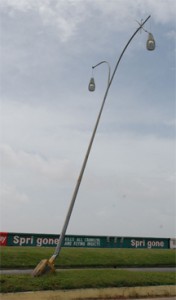By Heppilena Ferguson
Reckless motorists and vandals have caused damage to some 13 of the 47 modern traffic lights installed less than a year ago.

Concerned as it has always been about road accidents, the Mothers in Black organisation believes that while the traffic lights are extremely necessary their full effectiveness was still not being felt, particularly because their introduction was not preceded by a public education campaign.
In an invited comment to this newspaper, founder of the organization, Denise Dias, who is also Vice-Chairperson of the National Road Safety Council said that prior to the installation of the lights, enough emphasis was not placed on educating the public in their use.
“People are still confused with the lights and this is mainly because we did not have a good public education programme,” she said.
She said too that the countdown system on the lights might be a source of the confusion since many times motorists just sped off from intersections as soon as the count reached one and this created havoc.
She said too that the traffic lights might have been set up at intersections too close to each other.
With regard to their suitability, Dias said she would have recommended overhead traffic lights for Guyana, but admitted that it was now too late.
She noted that in many countries, traffic lights were set up in the same way as Guyana’s and the solar panels and batteries remained untouched.
Many of the batteries installed alongside the traffic lights have been stolen by vandals resulting in disruption to the lights whenever there is a power outage in a particular area.
This forced the ministry to remove the batteries from some of the traffic lights since it was feared that the vandals would go around all of the lights removing batteries.
Other than the lights being too close together, they are not suitable for the country’s narrow streets, Dias said.
Mothers in Black believes that on an average day there is still excessive speeding on the roadways, and although there are radar guns and a heightened police presence on the street during the day, the speeding and recklessness continues after five in the evenings.
Dias’s daughter Alecia Gouveia was killed several years ago in a road accident caused by a man driving recklessly.
In an invited comment, Traffic Safety Engineer Kadri Parris said that the largest sum of money spent so far on repairing a set of lights was in excess of $3.1 million.
The installation of the lights started on January 27, 2007 and was completed on July 11. The official commissioning was done on July 21 at a simple ceremony at Cenotaph Square.
The traffic lights were installed by an Indian firm through a line of credit of US$2.1 million extended to Guyana by the Government of India.
However, even though the initial introduction of the lights brought some relief to the Police Traffic Department and restored some amount of order in the city, speeding and breach of signals were still the main causes for damage to the lights.
Reducing the impact which traffic accidents could cause to the traffic light poles is a problem because of constraints of space.
Transport Minister Robeson Benn recently told this newspaper that the ministry was examining the possibility of erecting some kind of barricade in front of the lights so that in the event of any future accidents, the lights would be protected from the full impact of a collision.
Parris said many motorists had to pay for the damage they had caused to the traffic lights, a sum which varied according to the extent of the damage caused. According to him, some of them had already started working out repayment plans with the ministry.
He said it was apparent that most of the accidents were caused by intoxicated drivers, while some were a result of persons breaching the signals. Others appeared to be cases of motorists just losing control of their vehicles. He observed too that most of the accidents involving damage to traffic lights occurred in central George-town. Referring to a recent accident at the corner of D’Urban and Haley streets, Parris said the matter was currently engaging the attention of the courts and noted that the ministry would be claiming for damages.
“We don’t want to make people feel that it’s okay to just destroy the lights and then we will have to spend money to repair them, because if we have to keep paying to replace parts and repair them it could challenge out ability to continue to make the system viable,” Parris said.
He said it was either 12 or 13 of the 47 traffic lights installed that had already been damaged by vandals and motorists, and local engineers have had to undertake frequent interventions.
However, he said, they were competent enough to deal with the repairs since they had been trained by the Indian engineers who were in Guyana to do the full installation. He said too that some time this month, one of the engineers was expected in the country to carry out maintenance as part of the contractual arrangement. When the traffic lights were officially commissioned, Home Affairs Minister Clement Rohee had said he felt they had launched an attack on the culture of lawlessness eating away at the traffic laws. He had also used the occasion to urge more discipline on the part of motorists. He had pointed too to the lack of vigilance demonstrated by pedestrians. Rohee had said too that the lights were public property and it was the duty of the citizenry, the state and the society to play a part to ensure they were protected.
Again, he had signalled government’s intention to move to the National Assembly to table legislation dealing with the use of breathalyzers for motor vehicle drivers. This is yet to become a reality.




